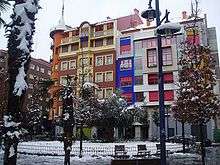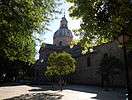Talavera de la Reina
| Talavera de la Reina | |||||||
|---|---|---|---|---|---|---|---|
| Municipality | |||||||
Clockwise from top: Basilica of Nuestra Señora del Prado, albarrana tower, general view from the North, San Prudencio, Colegial Church of Saint Mary the Great | |||||||
| |||||||
 Talavera de la Reina Location in Spain | |||||||
| Coordinates: 39°57′30″N 4°49′58″W / 39.95833°N 4.83278°WCoordinates: 39°57′30″N 4°49′58″W / 39.95833°N 4.83278°W | |||||||
| Country |
| ||||||
| Autonomous community |
| ||||||
| Province | Toledo | ||||||
| Comarca | Tierras de Talavera | ||||||
| Judicial district | Talavera de la Reina | ||||||
| Government | |||||||
| • Alcalde | Jaime Ramos (2014-today) (PP) | ||||||
| Area | |||||||
| • Total | 185.83 km2 (71.75 sq mi) | ||||||
| Elevation | 373 m (1,224 ft) | ||||||
| Population (2009) | |||||||
| • Total | 88,856 | ||||||
| • Density | 480/km2 (1,200/sq mi) | ||||||
| Demonym(s) | Talaveranos | ||||||
| Time zone | CET (UTC+1) | ||||||
| • Summer (DST) | CEST (UTC+2) | ||||||
| Postal code | 45600 | ||||||
| Climate | BSk | ||||||
| Official language(s) | Spanish | ||||||
| Website |
www | ||||||
Talavera de la Reina[1] is a city and municipality in the western part of the province of Toledo, which in turn is part of the autonomous community of Castile–La Mancha, Spain. It is the second-largest population center in Castile–La Mancha. Its population of 83,793[2] makes it larger than the city of Toledo, although the latter remains the provincial capital.
The city is settled along the river Tagus (Tajo in Spanish) at a broad bank. There are two islands in the center of the city called Isla Grande and Chamelo Island. The city is surrounded by two ranges of mountains, in the north the Sierra de San Vicente, and in the south Montes de Toledo.
The city is divided in two by the river Tagus. The northern part is the larger and more populated; both parts are connected by three bridges, one of them built in the Middle Ages.
Talavera has a transition climate between the harsher continentalized mediterranean climate of the central table land and the mild-winter mediterranean climate of nearby Extremadura; Summers are hot and extremely dry and winters are moderately mild cool. Overall the climate is slightly warmer than Madrid. The area is very fertile with Mediterranean forests, elms, olive trees and corks.
Pottery


The city is internationally known for its ceramics, which Philip II of Spain used as tiled revetments in many of his works, such as the monastery of El Escorial. The nickname of Talavera de la Reina is 'The City of Pottery' (La Ciudad de la Cerámica, in Spanish). Mexico's famous Talavera pottery was named after the city.
Toponymy
There are remnants of prehistoric cultures in the area. The village was founded by the Celts as a ford of the Tagus. The first mention of the city (with the name Aebura) occurs in Livy's description of a battle between the Romans and the Carpetanoi, a Celtiberian tribe. After the Roman conquest of Hispania, it was known as Caesarobriga, one of many Celtic toponyms preserved in Roman Hispania, with a name connoting "fortified" that was extended to many non-fortified rowns: "Caesarburg".[3] Caesarobriga served as an important center for agriculture and ceramics in the 3rd and 4th centuries BCE During the Visigothic period, Talavera reverted to a variant of its Celtiberian name: Elbora or Ebora. Its modern name is derived from Talabayra, the Muslim rendering of this Visigothic name. The city was conquered by Muslim forces in 713 and conquered by Christian forces under Alfonso VI of Castile in 1083.
History
Foundation


Talavera de la Reina was founded at the confluence of the rivers Alberche and Tagus. This area of great ecological wealth was the settlement of Celtic people who built the most ancient ruins of the area.
Roman Empire and Visigothic Age
During the time of the Roman Empire the name of the city was Caesarobriga. In 182 BCE Quintus Fulvius Flaccus conquered the city, establishing it as part of the Roman province of Lusitania as a city that would pay a stipend, and as the capital of an extended area included in the legal convent of the city of Emerita Augusta. The leader Viriato, in his war against the Romans, lived in this territory between 145 and 139 BCE. In this period Talavera de la Reina was a rich city with cattle markets and commercial exchange. Christianity came early to the city, and with the fall of the Western Roman Empire the Visigoths established in the city. Talavera was known then as (Aküis) or (Aibura). In the year 602, King Liuva II made a present to the city: the sculpture of the Virgin Mary, who was from then to the present day the symbol of the Christians in Talavera de la Reina, and the substitute for the goddess Ceres. In honour of the goddess Ceres, Talaverian Romans celebrated the spring festival called Mondas, which is still celebrated for the Virgin Mary.
Muslim conquest
The Muslims conquered Talavera in 712. They built new walls and a castle in Talavera. They also brought the use of fountains, water mills and new products brought from Africa and Asia. The fertile soil produced quality vegetables, fruits and grass for animal feed. The markets gained new strength, and the population, a mixture of Christians, Muslims and Jews, lived in harmony for some centuries. Medina Al Talavayra took part in different wars between the kingdoms of Spain, becoming allied with Córdoba and Badajoz. Talavera was the capital of an ephemeral kingdom or taifa (principality). After the city was reconquered in the 11th Century by Alfonso VI, it was an important trade center in medieval Spain.
High Middle Ages
King Sancho IV gave the royal privilege to hold two royal markets each year.
15th and 16th centuries
During the 15th and 16th centuries, Talavera achieved great recognition, thanks to its pottery. Wonderful pieces of pottery and Talavera tiles are found in the main museums of the world and in the most luxurious palaces all over Europe.
Talaverian people participated in the conquest of America, like Francisco de Aguirre, Juan de Orellana and Jofrén de Loaisa.
Other important Talaverian people were Hernando de Talavera, Isabella I of Castile's confessor, and the Admiral Francisco Verdugo. The beginning of the 16th century saw the release of the most important theater work in Spanish literature, The Tragicomedy of Calixto and Melibea, or Celestina, written by the Talaverian mayor Fernando de Rojas.
17th century
During this century the city lived in a golden age of arts and culture. Its main exponent is the father of Spanish History, Juan de Mariana, who wrote several books about history, law and politics, and who was very important for French revolutionary theories.
18th and 19th centuries
Upon the death of King Charles II in November 1700, two powerful nations fought for the Spanish Crown. Talavera supported Philip V's French faction, which was the winner. In 1750 the king founded the Royal Seeds Factories in Talavera, and 4,000 people worked there.
The war of independence against Napoleon's army had great consequences for Talavera. On July 27 and July 28, 1809 the Battle of Talavera took place between the Anglo-Spanish army and the French. During the fight the city was hardly damaged. The Duke of Wellington's army expelled the French from the city.
Civil War and Franco period
The city was getting large during the beginning of the 20th century. The railroad brought new opportunities for improvement. In 1931 the Republic was the new political system in Spain. Talavera changed its name to Talavera del Tajo. On July 18, 1936, when the Nationalists had risen in arms, the Republicans opened a period of terror in Talavera, killing people. On September 3 the Nationalist army conquered Talavera and reopened the terror, this time against communists and socialists. During the rest of the war Talavera de la Reina was damaged by the Republican bombing attacks.
During the Franco period there was a recovery project by the Instituto Nacional de Colonización that created a large irrigated zone in Talavera, following which two new municipalities were created, called Talavera la Nueva and Alberche del Caudillo, the latter located in neighboring Calera y Chozas municipal term. During the 1960s a baby boom caused an increase in the population, added to by the immigrants coming from the nearby villages and poor areas of Extremadura.

Today
In 1975 Franco died, and democracy came to Spain. Talavera's first democratic mayor tried to create the province of Talavera, but the idea was not successful. The next mayor, Pablo Tello from the Socialist Party, made large projects such as the Alameda Park.

In 1989 a feeling of marginalization enveloped the city, and a group of people called "Nosotros Talavera" (we Talavera) started fighting for the creation of a University Campus and other projects for the city.
The University started classes in 1994.
Transportation
The city is located at the intersection of Autovía A-5 (part of European route E90) and N-502. It is on the railway route between Madrid and Badajoz. Talavera de la Reina's city bus system is Eborabus.
Notable people
Talavera de la Reina is the birthplace of footballer Manu Trigueros who plays for Villarreal and poet Rafael Morales.
International relations
Twin towns – Sister cities
Talavera de la Reina is twinned with:
See also
References
- This article is partly drawn from the corresponding article in the Spanish-language Wikipedia, retrieved October 16, 2004.
Notes
- ↑ Talavera of the Queen distinguishes it from Talavera, Lleida, in Segarra, Catalonia
- ↑ Instituto Nacional de Estadística, Spanish National Statistics Institute.
- ↑ Juan Luis García Alonso, "-Briga Toponyms in the Iberian Peninsula," e-Keltoi 6
- ↑ "Radom - Miasta partnerskie" [Radom - Partnership cities]. Miasto Radom [City of Radom] (in Polish). Archived from the original on 2013-04-03. Retrieved 2013-08-07.
- ↑ "Radom - miasta partnerskie" (in Polish). radom.naszestrony.pl. Retrieved 2013-08-07.
External links
| Wikimedia Commons has media related to Talavera de la Reina. |
- Official website (in Spanish)
- Talavera, official tourist web site
- Web oficial del Ayuntamiento de Talavera de la Reina
- La Guia de Talavera de la Reina
- Web oficial Turismo Talavera de la Reina
- El Portal de Talavera de la Reina
- Talavera se mueve



